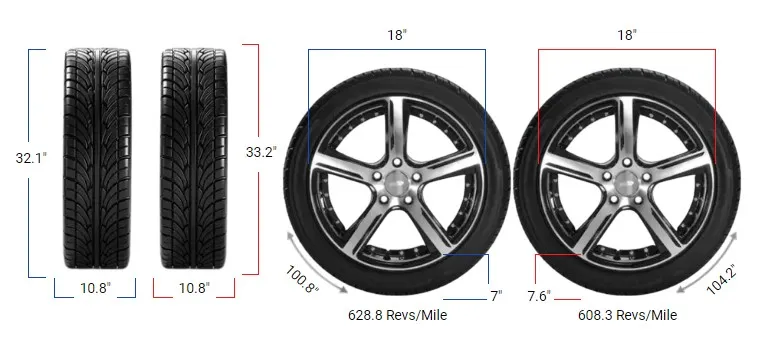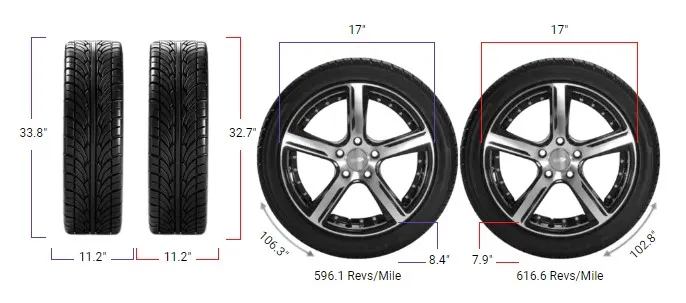Tire Size 255/70r16 vs 245/75r16
 Switching from 255/70R16 to 245/75R16 tires might sound simple, but understanding the impact is crucial. Let’s dive into the details to make an informed decision.
Switching from 255/70R16 to 245/75R16 tires might sound simple, but understanding the impact is crucial. Let’s dive into the details to make an informed decision.
- The 245/75R16 has a larger diameter, providing slightly better ground clearance.
- A narrower width can improve fuel efficiency.
- The increased sidewall height may enhance ride comfort on uneven roads.
- The larger circumference can lead to better stability at higher speeds.
- A reduction in revolutions per mile may impact speedometer accuracy.
- The switch may offer a more cushioned ride due to the taller sidewall.
- The 255 tire may provide more traction in certain conditions.
- Fitting the narrower tire could improve compatibility with tighter wheel wells.

Fitment Guide
According to tire fitment guidelines, replacement tires should be within 3% of the original tire’s overall diameter. For the tire sizes in question, 255/70R16 and 245/75R16, the difference falls within this acceptable range, making them a viable option.
If the diameter difference exceeds this range, an interchange isn’t recommended due to potential issues like rubbing or clearance problems.
On-Road Impact
Switching tire sizes can significantly influence your vehicle’s on-road performance. Let’s explore how the 245/75r16 compares to the 255/70r16 in everyday driving conditions.
Ride Comfort
The 245/75r16 tires have a taller sidewall height of 7.23 inches compared to the 7.03 inches on the 255/70r16.
A taller sidewall can absorb more road imperfections, potentially offering a smoother ride over potholes and rough surfaces. This can enhance passenger comfort during daily commutes.
Handling & Stability
With a width of 9.65 inches, the 245/75r16 is narrower than the 10.04-inch wide 255/70r16. This decrease in width can affect the tire’s contact patch with the road, possibly leading to a minor reduction in handling performance, especially during sharp turns or sudden maneuvers.

Fuel Efficiency
The narrower 245/75r16 tires might contribute to improved fuel efficiency due to reduced rolling resistance.
Less surface area in contact with the road means the engine doesn’t have to work as hard to keep the vehicle moving, potentially saving on gas mileage over time.
Speedometer Accuracy
The 245/75r16 tires have a slightly larger overall diameter, resulting in a 1.4% increase in circumference. This means when your speedometer reads 60 mph, your actual speed is approximately 60.84 mph.
While the difference is minimal, it could accumulate over longer distances, affecting odometer readings and fuel calculations.
Aesthetic Appearance
Switching to 245/75r16 tires will subtly change your vehicle’s look. The taller sidewall gives a beefier appearance, while the narrower width may make the tires look less aggressive. Depending on personal preference, this could be seen as a positive or negative change.
Traction on Pavement
The wider 255/70r16 tires generally offer better traction on dry pavement due to a larger contact patch.
The narrower 245/75r16 may have slightly reduced grip, particularly in wet conditions, but the difference is often negligible for daily driving.
Durability and Wear
The 245/75r16’s taller sidewall may flex more under load, potentially leading to increased heat build-up and faster wear under heavy usage.
However, modern tire compounds and construction often mitigate these effects, resulting in comparable longevity between the two sizes.

Off-Road Impact
Off-road enthusiasts know that tire selection can make or break an adventure. Let’s examine how the switch to 245/75r16 tires influences off-road performance.
Ground Clearance
The slightly larger diameter of the 245/75r16 tires increases ground clearance by approximately 0.2 inches. While seemingly minor, this added height can be beneficial when navigating obstacles on rough terrain, reducing the risk of underbody damage.
Off-Road Traction
The taller sidewall of the 245/75r16 allows for better tire flex when aired down, enhancing traction on uneven surfaces. The narrower width can also help the tire cut through soft surfaces like sand or mud, providing better grip in certain off-road conditions.
Sidewall Strength
A taller sidewall can be more susceptible to punctures from sharp rocks or debris. However, many off-road tires are reinforced to handle such conditions.
The difference in sidewall height between these two sizes is minimal, so the risk increase is marginal.
Vehicle Capability
Switching to 245/75r16 tires may slightly alter your vehicle’s gear ratios due to the change in tire circumference. This can affect torque and power delivery, potentially improving low-end performance—a desirable trait for off-road crawling.
Mud and Snow Performance
The narrower 245/75r16 tires can perform better in mud and snow by cutting through to firmer ground, whereas wider tires may float on top. This can enhance traction in slippery conditions, making the 245/75r16 a better choice for certain off-road environments.
255/70r16 vs 245/75r16
This table compares the key features of tire sizes 255/70R16 and 245/75R16.
| Feature | 255/70R16 | 245/75R16 | Difference |
|---|---|---|---|
| Diameter inches (mm) | 30.06 (763.4) | 30.47 (773.9) | 0.41 (10.5) 1.4% |
| Width inches (mm) | 10.04 (255) | 9.65 (245) | -0.39 (-10) -3.9% |
| Circumference inches (mm) | 94.42 (2398.29) | 95.72 (2431.28) | 1.3 (32.99) 1.4% |
| Sidewall Height (mm) | 7.03 (178.5) | 7.23 (183.75) | 0.21 (5.25) 2.9% |
| Revolutions per mile (km) | 671.04 (416.96) | 661.93 (411.31) | -9.1 (-5.66) -1.4% |
| Speedo Reading | 20 mph | 20.28 mph | +0.28 mph |
Difference Between 255/70R16 and 245/75R16
The main difference is width, the 255/70R16 tire is 0.39 inches (10 mm) wider than the 245/75R16 tire, providing a broader footprint.
Can I Use 245/75R16 Instead of 255/70R16?
Yes, you can use a 245/75R16 tire instead of a 255/70R16. The diameter difference is only 1.4%, which is within the recommended 3% range, but the 245/75R16 is slightly narrower.
How Much Taller Is a 245/75R16 Tire Than a 255/70R16?
The 245/75R16 tire is 0.41 inches (10.5 mm) taller than the 255/70R16, representing a 1.4% increase in overall diameter.
How Much Wider is a 255/70R16 Tire Than a 245/75R16?
The 255/70R16 tire is 0.39 inches (10 mm) wider than the 245/75R16, providing a 3.9% increase in width for better traction.
Our Observation
Switching from 255/70r16 to 245/75r16 tires involves trade-offs that may or may not align with your driving needs. On-road, the differences are relatively subtle.
The slightly narrower width may marginally reduce handling performance and road grip, but it could also improve fuel efficiency. The taller sidewall might enhance ride comfort by better absorbing road imperfections.
Off-road, the increased ground clearance and improved ability to cut through soft terrain could be advantageous. However, the minimal differences in dimensions mean that many of these effects are slight and may not be noticeable to the average driver.
Ultimately, the decision should be based on your specific driving conditions and preferences. For most users, the differences between these two tire sizes are negligible and won’t significantly impact daily driving or off-road excursions.



